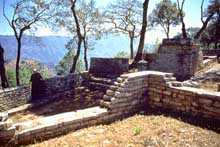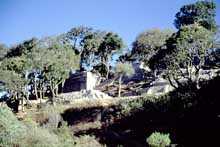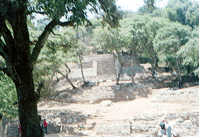
THE PYRAMIDS OF LAS RANAS |

Ranas Archaeological site , Located 1.8 miles from the community of San Joaquin, It is an ancient fortified city with a mural that surrounds the remains of the courts of the ancient Ball Game and the bases of ceremonial pyramids, also some of the living quarters, with stone beds, altars and stoves of the last people to inhabit this city.

The Pyramids of Las Ranas are well off the beaten path and are
practically unknown to foreign tourists, but they are the pride and
joy of the local inhabitants. They even feature, on the crest of San
Joaquin City, the typical, pre-Hispanic, pebbly rampart behind the
mine cart and five-string guitar, which symbolises the spirit of
native inhabitants from old times till nowadays.

No one seems to know when this pyramid was built or why it is named Las Ranas (The Frogs), but many believe that it dates back to around the 5th century, when the first inhabitants came to the area from Veracruz and formed a settlement that served as the political and religious centre of the region for which purpose a pyramid would have presumably been invaluable. By day, these people were dedicated to agriculture and mining, and at night, they loved playing Juego de Pelota (a ceremonial ball game played in teams, where it was not unknown for losers to be sacrificed!) in the flat area in front of these once-magnificent structures.

In the 8th century, these people, known as the Chichimecans, had to leave the area because of a long-lasting drought, and the area remained uninhabited until tribes of the Pames crossed the mountains of Sierra Gorda and settled here in 13th century, to be followed by the Jonaus in the 15th century. They doubtless were able to resurrect the crumbling remains of the old religious site, like a phoenix from the flames, as they lived a happy and prosperous life here. Safe from invasion on account of the fact that this place was not marked in any map of the time, even the catastrophe of the 13th August 1521, when Tehotiucan was conquered by nasty Spanish invaders, did not have much effect way out here. Even during the era known as the Chichimecan War, when the Spanish started to spread around Mexico, the local inhabitants still managed to keep their liberty lasting in defense for the next 27 years, until they lost at the battle of Cerro de Media Luna (Hill of Half-Moon).

After this defeat, the religious rituals on this site were stopped, and the structure started to pay its taxes to time, which it keeps paying it to this day. The local source of money is not sufficient for any reconstruction or salvation works, and there is not much left of its former greatness, but you can still see the remains of Las Ranas II, Atalya, and the Astronomic Observatory. So if you donít like crowds of tourists, and you still want to admire the ancient art of the native inhabitants, donít miss a pleasant stop while driving through Queretaro. Students and teachers can get in for free; otherwise, it costs only a few pesos, and with your visit, you might help to preserve the site for the next generation to find as peaceful and atmospheric as it is today.
| Campo Alegre | Las Grutas |
| Huapango |